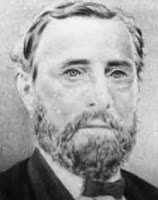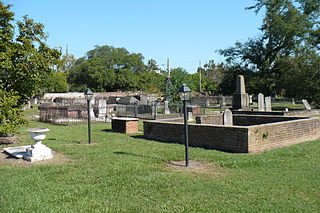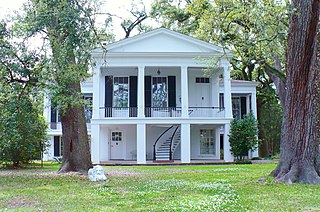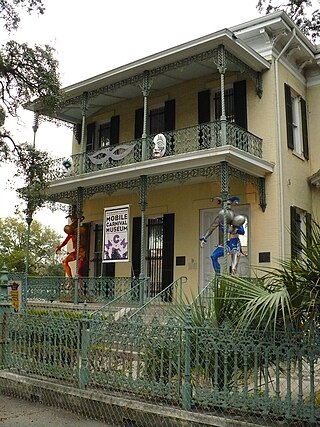
Mobile is a city and the county seat of Mobile County, Alabama, United States. The population was 187,041 at the 2020 census. After a successful vote to annex areas west of the city limits in July 2023, Mobile's population increased to 204,689 residents, making it the second-most populous city in Alabama, after Huntsville. Mobile is the principal municipality of the Mobile metropolitan area, a region of 430,197 residents composed of Mobile and Washington counties; it is the third-largest metropolitan area in the state.

Arlington House is the historic family residence of Robert E. Lee, commanding general of the Confederate Army during the American Civil War in Arlington County, Virginia. The estate of the historic home along with a memorial to Lee are now the center of Arlington National Cemetery in Arlington County, where they overlook the Potomac River and the National Mall in Washington, D.C.

Absolom Madden West was an American planter, Confederate militia general, state politician, railroad president and labor organizer. Born in Alabama, he became a plantation owner in Holmes County, Mississippi, and president of the Mississippi Central Railroad. He served in the American Civil War. After the war, he served in the Mississippi State Senate and ran for Vice President of the United States, unsuccessfully.

Samuel Sloan was a Philadelphia-based architect and best-selling author of architecture books in the mid-19th century. He specialized in Italianate villas and country houses, churches, and institutional buildings. His most famous building—the octagonal mansion "Longwood" in Natchez, Mississippi—is unfinished; construction was abandoned during the American Civil War.

Bulstrode is an English country house and its large park, located to the southwest of Gerrards Cross, Buckinghamshire. The estate spreads across Chalfont St Peter, Gerrards Cross and Fulmer, and predates the Norman conquest. Its name may originate from the Anglo-Saxon words burh (marsh) and stród (fort). The park and garden are designated a Grade II* listed building.

Bienville Square is a historic city park in the center of downtown Mobile, Alabama. Bienville Square was named for Mobile's founder, Jean-Baptiste Le Moyne, Sieur de Bienville. It takes up the entire block bordered by the streets of Dauphin, Saint Joseph, Saint Francis, and North Conception.

Church Street Graveyard is a historic city cemetery located in Mobile, Alabama. The cemetery is situated on 4 acres (1.6 ha) and is surrounded by a brick wall that dates back to 1830. At the time the cemetery was established, it lay about a half-mile away from most development, but it is now considered to be downtown.

Magnolia Cemetery is a historic city cemetery located in Mobile, Alabama. Filled with many elaborate Victorian-era monuments, it spans more than 100 acres (40 ha). It served as Mobile's primary, and almost exclusive, burial place during the 19th century. It is the final resting place for many of Mobile's 19th- and early 20th-century citizens. The cemetery is roughly bounded by Frye Street to the north, Gayle Street to the east, and Ann Street to the west. Virginia Street originally formed the southern border before the cemetery was expanded and now cuts east–west through the center of the cemetery. Magnolia contains more than 80,000 burials and remains an active, though very limited, burial site today.

Oakleigh is a c. 1833 historic house museum in Mobile, Alabama, United States. It is the centerpiece of the Oakleigh Historic Complex, a grouping of buildings that contain a working-class raised cottage, Union Barracks, and a modern archives building. The name for the estate comes from a combination of the word oak and the Anglo-Saxon word lea, which means meadow. The complex is within the Oakleigh Garden Historic District, the surrounding district and neighborhood being named after the estate.

The Mobile Carnival Museum is a history museum that chronicles over 300 years of Carnival and Mardi Gras in Mobile, Alabama. The museum is housed in the historic Bernstein-Bush mansion on Government Street in downtown Mobile.

The Bragg–Mitchell Mansion, also known as the Bragg–Mitchell House, is a historic house museum in Mobile, Alabama. It was built in 1855 by Judge John Bragg and is one of the most photographed buildings in the city as well as one of the more popular tourist attractions. The house has been attributed to John's brother, a local Alabama architect, Alexander J. Bragg.

The Oakleigh Garden Historic District is a historic district in Mobile, Alabama, United States. It was placed on the National Register of Historic Places on 13 April 1972. It is centered on Washington Square and was originally bounded by Government, Marine, Texas, and Ann Streets. A boundary increase on 30 January 1991 increased the boundaries to Rapier Avenue, Selma, Broad, and Texas Streets. The district covers 1,453 acres (5.88 km2) and contains 288 contributing buildings. The buildings range in age from the 1820s to the 1940s with most in a variety of 19th-century architectural styles.

Lougheed House, or as it was originally known Beaulieu, is a National Historic Site located in the Beltline district of Calgary, Alberta. Originally constructed in 1891 as a home for Senator James Alexander Lougheed KCMG PC KC and his wife Isabella Clarke Hardisty, the structure has since become an iconic heritage building in Calgary. Lougheed House is operated by Lougheed House Conservation Society, an independent, non-profit society devoted to the restoration and public enjoyment of the historic house and its Gardens.

The Amelia Stewart House, also known as the Carol O. Wilkinson House and William Hallett House, is a historic residence in Mobile, Alabama, United States. It was built in 1835, with a significant Greek Revival style addition to the front built in 1871. The house was placed on the National Register of Historic Places on May 29, 1992, based on its architectural significance.

George Bigelow Rogers (1870–1945) was an American architect, best known for the wide variety of buildings that he designed in Mobile, Alabama, including mansions in historic European styles and other private residences, churches and public buildings, and the first 11-story skyscraper in Mobile and the Southeast United States. Many of his structures have been listed on the National Register of Historic Places.
CSS Phoenix was a Confederate ironclad floating battery built at Selma, Alabama, from 1863–64.

Reverie is a historic Greek Revival mansion built circa 1858 in Marion, Perry County, Alabama. It now serves as a residence and also historic house museum. It is listed on the National Register of Historic Places as a contributing property to the West Marion Historic District and was recorded by the Historic American Buildings Survey. It is featured in Ralph Hammond's Antebellum Mansions of Alabama, Gregory Hatcher's Reverie Mansion and Gardens, and Jennifer Hale's Historic Plantations of Alabama's Black Belt.
Bessie Morse Bellingrath was an Alabama philanthropist known for developing the Bellingrath Gardens and Home, the historic home of Bessie Morse Bellingrath and her husband, Mobile Coca-Cola Company president Walter Bellingrath. Bellingrath is remembered for her work creating the Bellingrath Gardens, as well as her private philanthropy during the depression. She would pay people hundreds of dollars in exchange for a plant in their gardens, an afghan blanket she saw in a shop, or an overpriced antique. She was an honorary member-at-large of the Garden Clubs of America, and has been inducted into the Alabama Women's Hall of Fame.

The Kennedy House at 607 Government Street in Mobile, Alabama, was built by local landowner Joshua Kennedy, Jr in 1857.



















